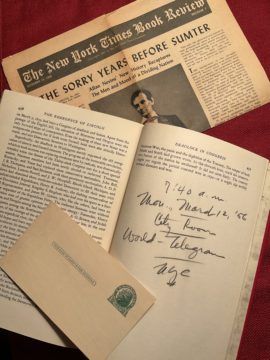by Michael Liss
 The word arrived from the furniture store. They have come! After five months of supply-chain suspended animation, our 15 feet of 72-inch-high bookcases are here. Bibliophiles everywhere (well, everywhere in my family) raised their voices in praise.
The word arrived from the furniture store. They have come! After five months of supply-chain suspended animation, our 15 feet of 72-inch-high bookcases are here. Bibliophiles everywhere (well, everywhere in my family) raised their voices in praise.
I’m excited. Seriously excited. My wife, son, and daughter are excited. While we already had a number of bookshelves and built-ins, their capacity was vastly exceeded by the books at hand. Those “loose” books were everywhere; turned flat, double-shelved, stacked on tables and desktops and chairs and nightstands. A shameful number of them were in boxes, embarrassed (you could hear them grumbling at times) that they were less loved. Some, even, had been exiled to a storage facility, enveloped in quiet beyond the whirr of ventilation systems.
Simple humanity cried out for a solution. Now, liberation was close at hand. The day after Thanksgiving (how’s that for a Providential intervention?), two strong men brought our prizes.
I was not there to witness this, needing to go to the office for a few hours, but my wife was, giving me play-by-play and texting me pictures. Wondrous, fantastic, spectacular. My mind wandered from the work-related tasks at hand. I fought it back with the idea that the sooner I got things done, the faster I would see the mighty oaks and start to grapple with the critical decisions of what went where. I escaped as soon as I could, leaving the strategic “out of the office for the holiday” auto-response on email.
A confession: I’m not good with spatial relations, particularly involving three dimensions. Fortunately, I married well, so a partial solution of how one stages different-sized books on shelves of unequal heights was available. My job was to provide a rational topic organization, then work out subgroups that permit the eye to grasp choices. One doesn’t just alphabetize (actually, one almost never alphabetizes) but finds like-minded books to play with one another.
Personally, I think Melvil Dewey, whose own system relies on relative position, would have approved. Others (I need not name names here) disagree with differing levels of intensity. But one thing became clear; my way of doing things (even if I were going to be largely confined to the 15 feet), combined with my interests, created a proximity problem.
Let’s explore that one more closely, especially now that where a book was to be placed was no longer entirely defined by limited options. If one is given a choice, how close should a tome about Cicero be to one about the Dark Ages, and that one to the Colonial period in the United States? Where does a Neustadt or a Barzun or Bronowski fit in? How about The Thirty Years War? The British Navy? Does the French Revolution belong closer to the Founders (or at least to Thomas Jefferson) or to Napoleon, or the Congress of Vienna, or Pierre Laval and the Collaborationist Vichy government? Is there potential interest in the Revolutions of 1848? The Hapsburg Empire? The Fuggers or the Rothschilds? Martin Luther (or Max Weber)? The rise of Bismarck and German Unification? Let’s work on those synergies before just random shelving.
Is it insane to care? By “care,” I don’t mean to be mean. Of course, we care about the topics, but do we care about the placement? It’s obviously easy to group what my children like to refer to as my “Hitler” books (hint to offspring: “World War II books” is both less harsh-sounding and more descriptive when you are including FDR, Churchill, Enigma, Operation Mincemeat, Japan, Mussolini, and those eternally woeful French).
You’ve probably noticed by now that we haven’t talked in the least about “my” fiction, humanities, science, or science fiction. In fact, those topics have a longstanding familial attraction to my other books—for many years, they hung out together in the living room, not far from those on the Civil War, baseball, Wall Street, the CIA, the FBI, and Watergate. McPhee was close to McPherson, Watergate near the Warren Report, Arthur Conan Doyle double-dated with David Donald, and Oliver Sachs was in the middle of everything, constantly talking. Herman Kahn (On Thermonuclear War) and Freud kept things light.
The truth was there wasn’t enough room on the 15 feet to accommodate all of those, so hard choices were made. Here’s where my wife stepped in. An edict was issued. “History and politics go in the new library.” Tricky Dick did not need to greet guests on the old living room shelves. He was headed to the new 15 feet (maybe to the farthest point of the 15 feet). So, too, JFK, Vietnam, the Supreme Court, and books about political cartoons. She had a point, and the living room began to get more of a vibe to it. But what would remain?
My son (who possesses my wife’s spatial skills and a certain meticulousness) came by, both to see to his books, and, more importantly, to help out on some of mine and those that were my mother’s. Discussions were had that I was not entirely privy to. Sherlock could stay where he was, as could Stephen J. Gould, Fromm, Simon Winchester, Hillary Mantel, and the Isaacs (Asimov and Singer). Occasionally I was called in. A quick question about The Naked Ape was asked and answered. A brief tussle over C.S. Forester’s “Hornblower” series was resolved by placing the books in the order they were published (Admiral Hornblower In The West Indies came later than Mr. Midshipman Hornblower). A bit of distance between them and Master and Commander, so there would be no misunderstandings.
A few random biographies remained in the living room, including ones on William Jennings Bryan, who really did belong with the American history, and the Medicis (who should be with the Medicis), but they were all a bit oversized, and I had used all the 15 feet’s bigger shelves. As is appropriate, the vast majority of my daughter’s copious collection of fiction, opera, and music theory stayed mostly in her old room. My cheesy paperback murder mysteries and spy novels on shelves in our bedroom. My wife’s far classier fiction, also in our bedroom.
We tossed some books that seemed to lack current relevance (how to get into the pre-K of your dreams, etc.). We stared at travel guides that were certainly dated. We raised a lot of dust. We grappled with, and failed to resolve, how to deal with my mother’s books. Although she and I shared some interests (including those cheesy murder mysteries, Peter Mayle, I.B. Singer, Studs Terkel), she just wasn’t into Clay, Calhoun, and Webster. Some of her books went back into boxes. Yes, I feel the shame.
 It’s now more than a week later. We aren’t done yet, of course, but there’s a bit of magic to the whole un-shelving and re-shelving thing. You find “stuff.” There was a picture of my father and his company taken during Basic Training. He didn’t look especially happy. Perhaps it was the Arkansas weather. A terrific caricature of my mother when she was in her twenties. She did look happy. My wife had a woven silk portrait of George Washington from 1932, designed for the bicentennial of his birth. It’s now adorning the “Founders” section.
It’s now more than a week later. We aren’t done yet, of course, but there’s a bit of magic to the whole un-shelving and re-shelving thing. You find “stuff.” There was a picture of my father and his company taken during Basic Training. He didn’t look especially happy. Perhaps it was the Arkansas weather. A terrific caricature of my mother when she was in her twenties. She did look happy. My wife had a woven silk portrait of George Washington from 1932, designed for the bicentennial of his birth. It’s now adorning the “Founders” section.
Of course, this is all logistics (fun logistics, but logistics). The real magic is in the books, and the people who wrote the books, and the people they wrote about, and the people who read those books. One I must mention here, by the great Allan Nevins, Volume I of The Emergence of Lincoln.
Nevins is one of my favorites. A journalist for more than two decades before joining Columbia’s history department, he wrote with a remarkable fluidity combined with extraordinary depth. Part of reading a Nevins volume is to accept that you won’t recognize every name, place, or event he cites because you can’t possibly have that degree of knowledge—but it’s perfectly fine, because along with telling, he’s also teaching. The big picture is never lost, even while all this texture is added. My tattered, thumbed, jacket-less copies of his eight-part The Ordeal of the Union (published between 1947 and 1971) are consulted any time I’m writing about the period, and sometimes just because.
I said I have eight volumes, but there’s a ninth, a duplicate of that Volume I of The Emergence of Lincoln. It’s a forgotten treasure, used, like the other eight, but lived in, devoured, and admired.
I don’t think I knew its specialness at the time I bought it. The Strand used to place price tags inside the front cover. This one was for $6 and was “pre-owned” by an Edward Ellis, a name that didn’t immediately register. I wanted the book; I scooped it up, and took it to checkout. I didn’t look at the inside beyond that.
If I had, I might not have bought it at all. Mr. Ellis had signed the inside front cover, dated it February 15, 1956, and claimed it for NYC. Then, he proceeded to absolutely manhandle the thing. Through the latter half of the 1850s went Nevins, and Ellis followed him. Page after page is filled with underlinings, “NB,” “IMP,” and exclamation points, all in thick-leaded pencil, sometimes done so vigorously that the lead darkened the following page. Sometimes he included notes to himself, clarifying the text. He even wrote a mini-index, placing issues with page numbers. Ellis didn’t just read, or just read for content, he seemed to consume the book.
Who was he? I had to find out, and he’d left some crumbs. Edward Robb Ellis was a newspaperman and a diarist, “the most prolific known diarist in the history of American letters” according to his 1998 obituary in The New York Times. He apparently wrote 22 million words in his diary, encompassing 70 volumes, the hard copies of which are now part of the Fales Library at NYU. You can access them at if you dare. He also found time to write several other books, including, in 1966, what was then thought of as a seminal history of New York City itself, The Epic of New York City.
For all that, he was not a native New Yorker. Ellis was born in the Midwest, and moved to jobs in several other cities, before coming to New York in 1947 to take a position with the New York World-Telegram. Apparently smitten with the City the moment he arrived at Grand Central Station, he stayed, taking notes during the day, typing them up at night. At the time of his death, he lived in a rundown apartment in a 19th Century Chelsea townhouse surrounded by his papers and what he estimated to be between 10,000 to 15,000 books.
This particular volume could not be one of those, since the Strand sticker was from 1989. Of course, it’s entirely possible that he might have bought his original copy there and sold it back to them, but if he started to read it in February of 1956, he was taking it up six years after it was originally published. It couldn’t have been to write a book review himself.
 Whatever circuitous route, it was here in my hands, and offered up two additional treasures, a one-penny postcard featuring Jefferson, and the original 1950 review in The New York Times Review of Books by Jay Monaghan. In those days, newspaper research departments kept massive volumes of clippings, and I imagine he might have “sourced” his there. It’s fun to look at the review…it runs over to another page that insists “You Don’t Need A Lot Of Money To Retire,” and promotes “For every parent and teacher of teen-agers, and for teen-agers themselves, ‘But You Don’t Understand’ by Frances Bruce Strain.”
Whatever circuitous route, it was here in my hands, and offered up two additional treasures, a one-penny postcard featuring Jefferson, and the original 1950 review in The New York Times Review of Books by Jay Monaghan. In those days, newspaper research departments kept massive volumes of clippings, and I imagine he might have “sourced” his there. It’s fun to look at the review…it runs over to another page that insists “You Don’t Need A Lot Of Money To Retire,” and promotes “For every parent and teacher of teen-agers, and for teen-agers themselves, ‘But You Don’t Understand’ by Frances Bruce Strain.”
Ellis clearly did understand, or at least he understood Nevins. There’s something quite human about his annotations. As Nevins passes the Lincoln-Douglas Debates, he starts to race towards the next volume in the series, and Ellis goes with him. The markings and annotations in the last couple of chapters diminish. But on March 12, 1956, at 7:40 a.m., in the City Room of the World-Telegram, he gets to the end with a flourish. A job well done.
Every good book deserves at least one reader like Edward Ellis. And a volume like this one deserves to be kept. I have a lot of stacking and reorganization ahead of me, but I’ll make sure we always have room for him.
